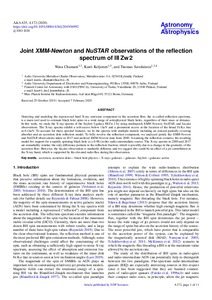Joint XMM-Newton and NuSTAR observations of the reflection spectrum of III Zw 2
Karri Koljonen; Tuomas Savolainen; Wara Chamani
Joint XMM-Newton and NuSTAR observations of the reflection spectrum of III Zw 2
Karri Koljonen
Tuomas Savolainen
Wara Chamani
EDP SCIENCES S A
Julkaisun pysyvä osoite on:
https://urn.fi/URN:NBN:fi-fe2021042822204
https://urn.fi/URN:NBN:fi-fe2021042822204
Tiivistelmä
Detecting and modeling the reprocessed hard X-ray emission component in the accretion flow, the so-called reflection spectrum, is a main tool used to estimate black hole spins in a wide range of astrophysical black holes, regardless of their mass or distance. In this work, we study the X-ray spectra of the Seyfert I galaxy III Zw 2 by using multiepoch XMM-Newton, NuSTAR, and Suzaku observations. The X-ray spectra exhibit a soft-excess below 1 keV and a prominent excess at the location of the broad Fe K alpha line at 6.4 keV. To account for these spectral features, we fit the spectra with multiple models including an ionized partially covering absorber and an accretion disk reflection model. To fully resolve the reflection component, we analyzed jointly the XMM-Newton and NuSTAR observations taken in 2017 and archival XMM-Newton data from 2000. Assuming the reflection scenario, the resulting model fits support for a rapidly spinning black hole (a >= 0.98) in this radio-intermediate source. The X-ray spectra in 2000 and 2017 are remarkably similar; the only difference pertains to the reflection fraction, which is possibly due to a change in the geometry of the accretion flow. However, the Suzaku observation is markedly different, and we suggest this could be an effect of a jet contribution in the X-ray band, which is supported by the elevated radio flux during this observation.
Kokoelmat
- Rinnakkaistallenteet [19207]
